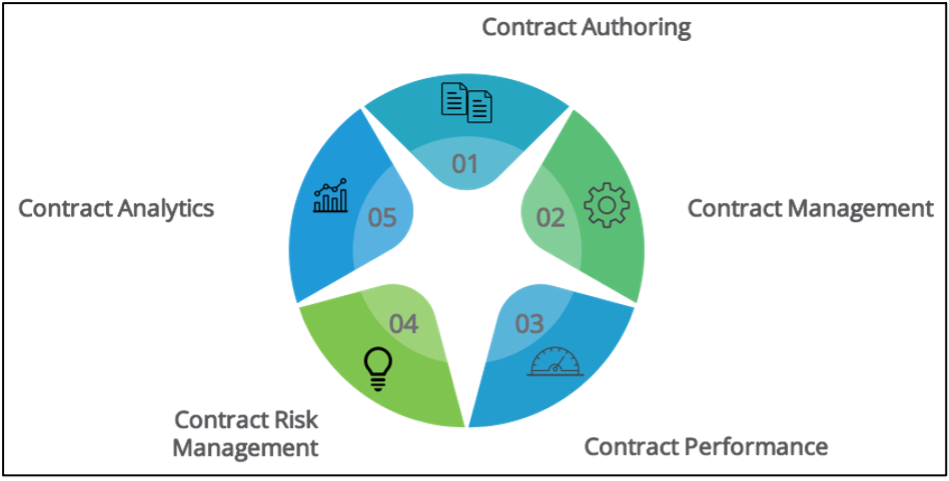Dive into Contract Lifecycle Management Capabilities
Learning Objectives
After completing this unit, you’ll be able to:
- Describe Industries CLM capabilities.
- Explain different approaches to contract lifecycle management.
Functional Capabilities
Let's see what’s in the box. The Industries CLM solution gives you several functional capabilities, including contract authoring, sales process integration, and lifecycle management.
The diagram shows you the components of each capability.

Industries CLM runs on top of Salesforce, Sales Cloud, and Service Cloud.
Now it’s time to zoom in and learn more about each capability.
Contract Authoring
Industries CLM gives you several contract-authoring benefits.
- A clause library provides reusable, pre approved legal language and terms to standardize and accelerate contract creation.
- Sales teams can use the document template designer to create relevant and accurate contract documents with little or no IT support.
- During negotiation, document reconciliation helps you to synchronize changes in Word documents to reflect customer-modified terms.
-
Redlining lets you track changes in different contract versions during contract authoring.
-
Version management controls versioning of contracts. For instance, when you customize a contract by making a change, a new version is automatically created.
- With template-based document generation, you can create dynamic contract documents. Customize and redline the documents online, while managing contract versions.
Sales Process Integration
You can integrate Industries CLM throughout the sales cycle, from contract authoring to enforcement.
- Sales teams can create contracts from opportunities, quotes, and orders.
- Automatic renewal notifications for expiring contracts help maximize revenue opportunities.
- The framework agreement foundational components ensure customer orders comply with the prices negotiated in contracts.
Lifecycle Management
Each contract progresses through a “lifecycle”, which begins with contract creation and ends with contract completion. Compliance requirements are an important part of managing the contract lifecycle.
Industries CLM provides contract lifecycle configuration, a contract state model, and integration with DocuSign for eSignatures. Let’s explore the benefits.
-
Contract types help teams manage different kinds of contracts, each of which can have a different lifecycle. The contract type specifies the type of contract document, such as sales contract, non-disclosure agreement, or partnership agreement.
-
Contract state model determines the lifecycle of a specific contract type and controls the actions and operations available to certain users at each stage.
-
CLM integration with DocuSign streamlines the eSignature flow during contract attestation.
End-to-End Contract Lifecycle
Contracts have an impact on every aspect of business. Here’s a diagram that shows the standard end-to-end lifecycle of contracts.

CLM promotes efficiency, effectiveness, and compliance throughout the contract lifecycle.
-
Contract Authoring: Author, review, negotiate, and approve contracts online.
-
Contract Management: Manage contracts online with different stakeholders.
-
Contract Performance: Measure contract performance and service-level agreements (SLAs).
-
Contract Risk Management: Manage alerts on obligation reminders, SLA breaches, expiry risks, and clause evaluation during drafting.
-
Contract Analytics: Analyze the contract data and metadata with in-built analytics.
Generic Contract Lifecycle Stages
A contract goes through various stages throughout its lifecycle, and CLM streamlines and automates each stage.

The first stage is authoring, when the contract documents are drafted. With CLM, teams can generate contract documents with predefined templates. The next stage is negotiation, during which all the parties aim to agree on the contract’s language, tenure, terms, and conditions. After this, approvals are required from internal stakeholders. During this stage, CLM facilitates collaboration with internal teams, such as managers and legal. Next, the contract moves to the execution stage, when each party reviews, and electronically signs the agreement. Finally, once the contract is signed, it’s activated and goes into effect.
Let's now explore various ways that businesses can begin implementing contract management tools like CLM.
Approaches to Contract Management
Organizations that adopt CLM software are often at different maturity levels in terms of their contracting processes. Organizations looking for a CLM solution typically fall into one of these categories.
- The organization has no CLM software in place.
- They have a homegrown CLM system.
- A vendor provides their CLM solution, but they want to replace it.
This diagram shows the CLM adoption maturity curve and the maturity levels.

An organization can start at any maturity level and progress to the next level quickly with Industries CLM.
Level 1: Document Repository
In some organizations, contracts are just documents stored in a shared folder or held in a legacy application. At this maturity level, most contract activities are manual and disorganized, with poor lifecycle management and high infrastructure costs. CLM gives you document management capabilities, so that there is a central repository to store all the contract data.
Level 2: Visibility and Reporting
The next level includes organizations that have visibility of data and reporting, which helps them understand the key data in their contracts, such as expiration dates, terms, and payment intervals. CLM has a rich and extensible data model based on the Salesforce platform to store and surface key contract information. Bring your business up to this maturity level using the CLM data model and capabilities.
Level 3: Contract Authorization and Process Standardization
At this maturity level, the contracting process is standardized with a cloud-based template designing tool. With the state-model functionality of CLM, organizations can configure the contract lifecycle and control the actions that happen at each stage.
Level 4: Integration with Other Clouds
CLM integrates tightly with Industries CPQ (Configure, Price, and Quote) and Industries Order Management. With these solutions, sales teams can create new contracts with a single click. Teams use CLM to negotiate pricing agreements so that subsequent quotes and orders include pre-negotiated prices for specific customers.
Level 5: Digital and Optimized
This is the highest maturity level. The organization has completely automated their contracting process in the cloud and across multiple channels. Client-side software tools and inefficient paper-based signature processes are a thing of the past. Pre-delivered integration accelerates product launches. At this maturity level, CLM provides the organization with comprehensive value through digitization.